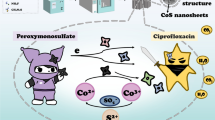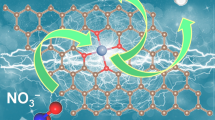Abstract
Carbonic anhydrases (CAs) have been given much attention as biocatalysts for CO2 sequestration process because of their ability to convert CO2 to bicarbonate. Here, we expressed codon-optimized sequence of α-type CA cloned from Dunaliella species (Dsp-aCAopt) and characterized its catalyzing properties to apply for CO2 to calcite formation. The expressed amount of Dsp-aCAopt in Escherichia coli is about 50 mg/L via induction of 1.0 mM isopropyl-β-d-thiogalactopyranoside at 20 °C (for the case of intact Dsp-aCA, negligible). Dsp-aCAopt enzyme shows 47 °C of half-denaturation temperature and show wide pH stability (optimum pH 7.6/10.0). Apparent values of K m and V max for p-nitrophenylacetate substrate are 0.91 mM and 3.303 × 10−5 μM min−1. The effects of metal ions and anions were investigated to find out which factors enhance or inhibit Dsp-aCAopt activity. Finally, we demonstrated that Dsp-aCAopt enzyme can catalyze well the conversion of CO2 to CaCO3, as the calcite form, in the Ca2+ solution [8.9 mg/100 μg (172 U/mg enzyme) with 10 mM of Ca2+]. The obtained expression and characterization results of Dsp-aCAopt would be usefully employed for the development of efficient CA-based system for CO2-converting/capturing processes.









Similar content being viewed by others
References
Puxty, G., Rowland, R., Allport, A., Yang, Q., Bown, M., Burns, R., Maeder, M., & Attalla, M. (2009). Carbon dioxide postcombustion capture: a novel screening study of the carbon dioxide absorption performance of 76 amines. Environmental Science & Technology, 43, 6427–6433.
Veawab, A., Tontiwachwuthikul, P., & Chakma, A. (1999). Corrosion behavior of carbon steel in the CO2 absorption process using aqueous amine solutions. Industrial and Engineering Chemistry Research, 38, 3917–3924.
Dawson, B., & Spannagle, M. (2009). The complete guide to climate change (1st ed.). New York: Routledge.
Lee, S. W., Park, S. B., Jeong, S. K., Limc, K. S., Lee, S. H., & Trachtenberg, M. C. (2010). On carbon dioxide storage based on biomineralization strategies. Micron, 41, 273–282.
Frommer, W. B. (2010). CO2mmon Sense. Science, 327, 275–276.
Figueroa, J. D., Fout, T., Plasynski, S., McIlvried, H., & Srivastava, R. D. (2008). Advances in CO2 capture technology—The U.S. department of energy's carbon sequestration program. International Journal of Green-House Gas Control, 2, 9–20.
Puskas, L. G., Inui, M., Zahan, K., & Yukawa, H. (2000). A periplasmic, α-type carbonic anhydrase from Rhodopseudomonas palustris is essential for bicarbonate uptake. Microbiology, 146, 2957–2966.
Smith, K. S., & Ferry, J. G. (2000). Prokaryotic carbonic anhydrases. FEMS Microbiology Reviews, 24, 335–366.
Tripp, B. C., Smith, K., & Ferry, J. G. (2001). Carbonic anhydrase: new insights for an ancient enzyme. Journal of Biological Chemistry, 276, 48615–48618.
So, A. K., Espie, G. S., Williams, E. B., Shively, J. M., Heinhorst, S., & Cannon, G. C. (2004). A novel evolutionary lineage of carbonic anhydrase (ε class) is a component of the carboxysome shell. Journal of Bacteriology, 186, 623–630.
Madern, D., Ebel, C., & Zaccai, G. (2000). Halophilic adaptation of enzymes. Extremophiles, 4, 91–98.
Mevarech, M., Frolow, F., & Gloss, L. M. (2000). Halophilic enzymes: proteins with a grain of salt. Biophysical Chemistry, 86, 155–164.
Szilagyi, F. A. U. A., & Zavodszky, P. (2000). Structural differences between mesophilic, moderately thermophilic and extremely thermophilic protein subunits: results of a comprehensive survey. Structure, 8, 493–504.
Borowitzka, M. A., & Borowitzka, L. J. (1988). Micro-algal biotechnology. New York: Cambridge University Press.
Fisher, M., Pick, U., & Zamir, A. (1994). A salt-induced 60-kilodalton plasma membrane protein plays a potential role in the extreme halotolerance of the alga Dunaliella. Plant Physiology, 106, 1359–1365.
Sambrook, J., & Russel, D. W. (2001). Molecular cloning: A laboratory manual (3rd ed.). Cold Spring Harbor: Cold Spring Harbor Laboratory Press.
Laemmli, U. K. (1970). Cleavage of structural proteins during the assembly of the head of bacteriophage T4. Nature, 227, 680–685.
Bradford, M. M. (1976). A rapid and sensitive method for the quantitation of microgram quantities of protein utilizing the principle of protein-dye binding. Analytical Biochemistry, 72, 248–254.
Rickli, E. E., Ghazanfar, S. A. S., Gibbons, B. H., & Edsall, J. T. (1964). Carbonic anhydrases from human erythrocytes: preparation and properties of two enzymes. Journal of Biological Chemistry, 239, 1065–1078.
Verpoorte, J. A., Mehta, S., & Edsall, J. T. (1967). Esterase activities of human carbonic anhydrases B and C. Journal of Biological Chemistry, 242, 4221–4229.
Mirjafari, P., Asghari, K., & Mahinpey, N. (2007). Investigating the application of enzyme carbonic anhydrase for CO2 sequestration purposes. Industrial and Engineering Chemistry Research, 46, 921–926.
Sharma, A., & Bhattacharya. (2010). Enhanced biomimetic sequestration of CO2 into CaCO3 using purified carbonic anhydrase from indigenous bacterial strains. Journal of Molecular Catalysis B: Enzymatic, 67, 122–128.
Lineweaver, H., & Burk, D. (1934). The determination of enzyme dissociation constants. Journal of the American Chemical Society, 57, 658–666.
Hakan, S., & Beydemir, S. (2012). The impact of heavy metals on the activity of carbonic anhydrase from rainbow trout (Oncorhynchus mykiss) kidney. Toxicology and Industrial Health, 28, 296–305.
Ceyhun, S. B., Sentürk, M., Yerlikaya, Emrah, Erdogan, O., Küfrevioglu, Ö. I., & Ekinci, D. (2011). Purification and characterization of carbonic anhydrase from the teleost fish Dicentrarchus labrax (European seabass) liver and toxicological effects of metals on enzyme activity. Environmental Toxicology and Pharmacology, 32, 69–74.
Ekinci, D., Ceyhun, S. B., Sentürk, M., Erdem, D., Küfrevioglu, Ö. I., & Supuran, C. T. (2011). Characterization and anions inhibition studies of an α-carbonic anhydrase from the teleost fish Dicentrarchus labrax. Bioorganic & Medicinal Chemistry, 19, 744–748.
Kupriyanova, E., Villarejo, A., Markelova, A., Gerasimenko, L., Zavarzin, G., Samuelsson, G., Los, D. A., & Pronina, N. (2007). Extracellular carbonic anhydrases of the stromatolite-forming cyanobacterium Microcoleus chthonoplastes. Microbiology, 153, 1149–1156.
Stahler, N. F., Ganter, L., Katherin, L., Manfred, K., & Stephen, B. (2005). Mutational analysis of the Helicobacter pylori carbonic anhydrases. FEMS Immunology and Medical Microbiology, 44, 183–189.
Innocenti, A., Muhlschegel, F. A., Hall, R. A., Steegborn, C., Scozzafava, A., & Supuran, C. T. (2008). Carbonic anhydrase inhibitors: inhibition of the β-class enzymes from the fungal pathogens Candida albicans and Cryptococcus neoformans with simple anions. Bioorganic & Medicinal Chemistry Letters, 18, 5066–5070.
Lindskog, S. (1997). Structure and mechanism of carbonic anhydrase. Pharmacology and Therapeutics, 74, 1–20.
Kuhad, R. C., Chopra, P., Battan, B., Kapoor, M., & Kuhar, S. (2006). Production, partial purification and characterization of a thermo-alkali stable xylanase from Bacillus sp. RPP-1. Indian Journal of Microbiology, 46, 13–23.
Sharma, A., Bhattacharya, A., & Singh, S. (2009). Purification and characterization of an extracellular carbonic anhydrase from Pseudomonas fragi. Process Biochemistry, 44, 1293–1297.
de Leeuw, N. H., & Parker, S. C. (1998). Surface structure and morphology of calcium carbonate polymorphs calcite, aragonite, and vaterite: an atomistic approach. Journal of Physical Chemistry B, 102(384), 2914–2922.
Ouhenia, S., Chateigner, D., Belkhir, M. A., Guilmeau, E., & Krauss, C. (2008). Synthesis of calcium carbonate polymorphs in the presence of polyacrylic acid. Journal of Crystal Growth, 310, 2832–2841.
Li, W., Liu, L., Chen, W., Yu, L., Li, W., & Yu, H. (2010). Calcium carbonate precipitation and crystal morphology induced by microbial carbonic anhydrase and other biological factors. Process Biochemistry, 45, 1017–1021.
Vinoba, M., Bhagiyalakshmi, M., Jeong, S. K., Yoon, Y. I., & Nam, S. C. (2012). Carbonic anhydrase conjugated to nanosilver immobilized onto mesoporous SBA-15 for sequestration of CO2. Journal of Molecular Catalysis B: Enzymatic, 75, 60–67.
Kim, I. G., Jo, B. H., Kang, D. G., Kim, C. S., Choi, Y. S., & Cha, H. J. (2012). Biomineralization-based conversion of carbon dioxide to calcium carbonate using recombinant carbonic anhydrase. Chemosphere, 87, 1091–1096.
Garcia-Carmona, J., Morales, J. G., & Clemente, R. R. (2003). Morphological control of precipitated calcite obtained by adjusting the electrical conductivity in the Ca(OH)2–H2O–CO2 system. Journal of Crystal Growth, 249, 561–571.
Vinoba, M., Kim, D. H., Lim, K. S., Jeong, S. K., Lee, S. W., & Alagar, M. (2011). Biomimetic sequestration of CO2 and reformation to CACO3 using bovine carbonic anhydrase immobilized on SBA-15. Energy & Fuels, 25, 438–445.
Acknowledgments
This work was supported by the National Research Foundation of Korea Grant funded by the Korean Government (MEST) (NRF-C1ABA001-2010-0020501).
Author information
Authors and Affiliations
Corresponding authors
Rights and permissions
About this article
Cite this article
Kanth, B.K., Min, K., Kumari, S. et al. Expression and Characterization of Codon-Optimized Carbonic Anhydrase from Dunaliella Species for CO2 Sequestration Application. Appl Biochem Biotechnol 167, 2341–2356 (2012). https://doi.org/10.1007/s12010-012-9729-1
Received:
Accepted:
Published:
Issue Date:
DOI: https://doi.org/10.1007/s12010-012-9729-1




